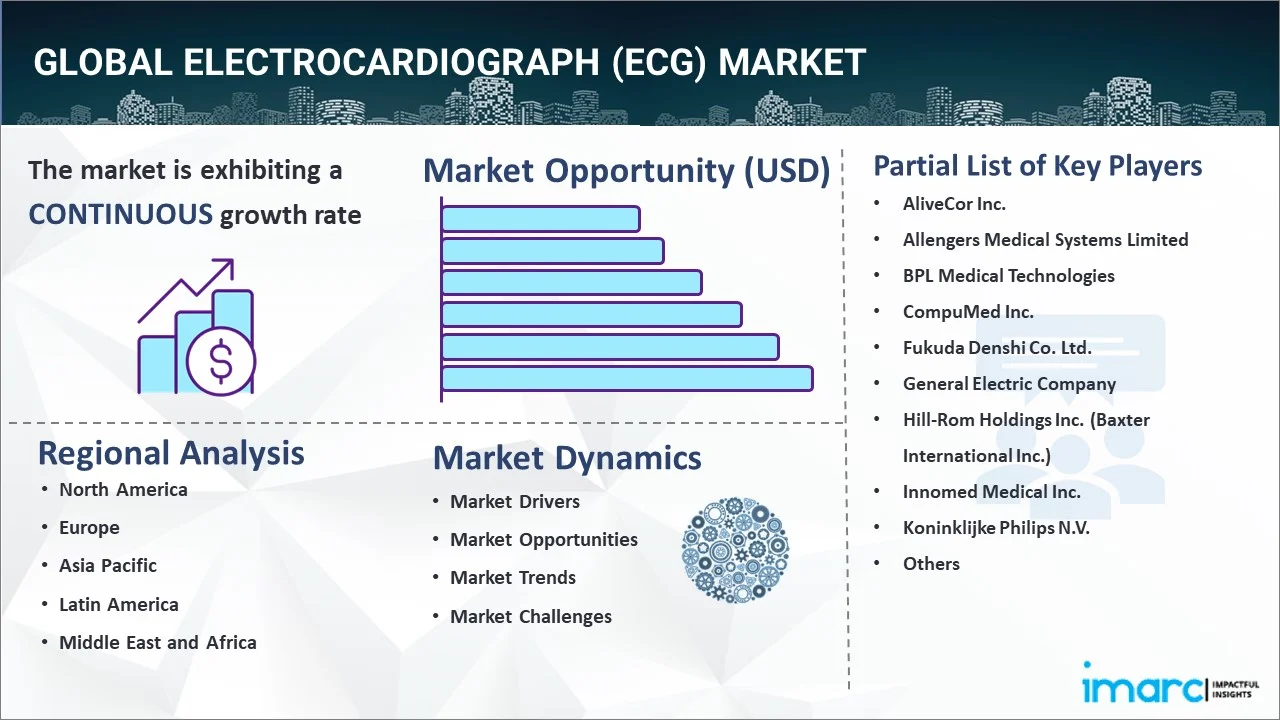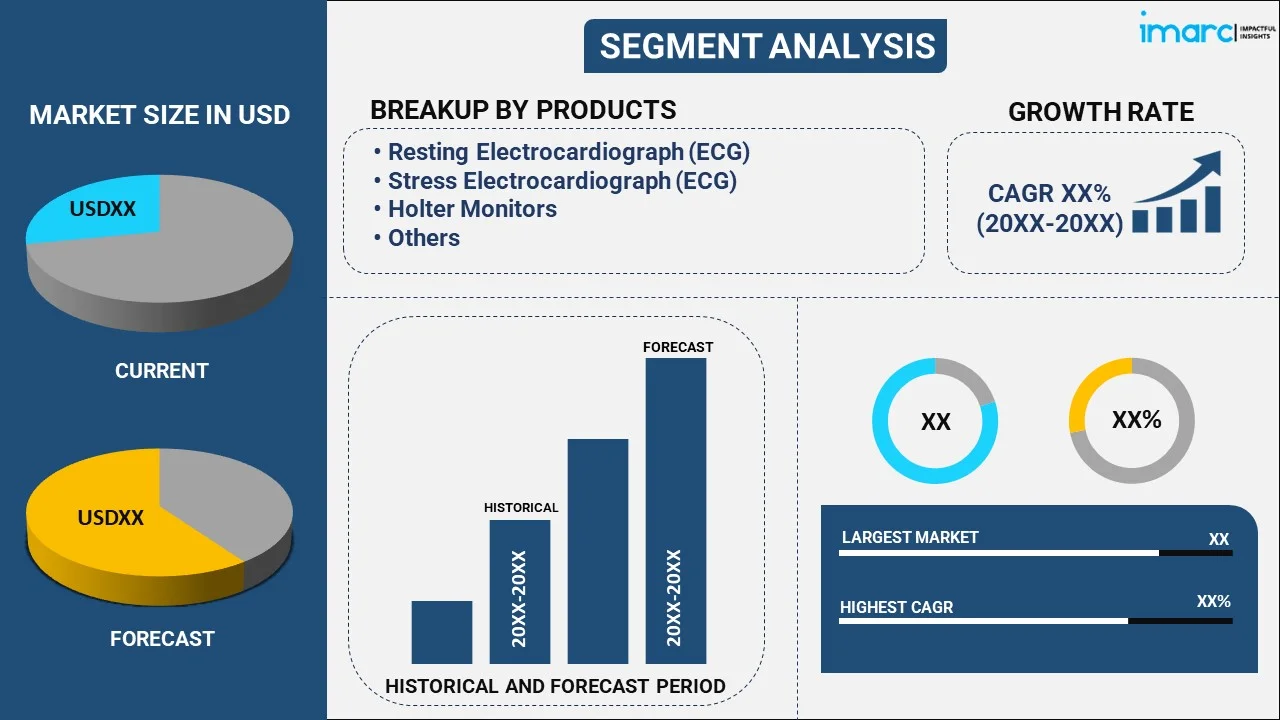
Electrocardiograph (ECG) Market Report by Product (Resting Electrocardiograph (ECG), Stress Electrocardiograph (ECG), Holter Monitors, and Others), Lead Type (Single Lead ECG, 2 Lead ECG, 3 Lead ECG, 6 Lead ECG, 12 Lead ECG), End User (Hospitals and Clinics, Home Settings and Ambulatory Surgical Centers (ASCs), and Others), and Region 2025-2033
Electrocardiograph (ECG) Market Size:
The global electrocardiograph (ECG) market size reached USD 10.2 Billion in 2024. Looking forward, IMARC Group expects the market to reach USD 15.3 Billion by 2033, exhibiting a growth rate (CAGR) of 4.32% during 2025-2033. The market growth is majorly driven by the rising healthcare awareness, technological advancements, and increasing prevalence of cardiovascular diseases. Moreover, the amplifying demand for enhanced diagnostic accuracy, portable ECG devices, and rapid development of healthcare infrastructure, particularly in emerging economies, further expands market.
|
Report Attribute
|
Key Statistics
|
|---|---|
|
Base Year
|
2024
|
|
Forecast Years
|
2025-2033
|
|
Historical Years
|
2019-2024
|
|
Market Size in 2024
|
USD 10.2 Billion |
|
Market Forecast in 2033
|
USD 15.3 Billion |
| Market Growth Rate 2025-2033 | 4.32% |
An electrocardiograph (ECG) records the electrical activity of the heart by measuring its surface potentials. With this painless, noninvasive procedure, it is possible to diagnose heart problems like arrhythmias and coronary artery disease, and the effectiveness of certain heart disease treatments. By conducting surface potentials from metal contacts called electrodes to an instrument, the electrical activity of the heart can be measured on the surface of the skin. A machine that measures ECGs is connected to these electrodes through cables that are placed on the chest, lower arms, and calves. ECG graphs are generated by the machine through the conversion of signals, whereas in some cases, they can also be printed. The use of ECG monitoring devices, such as resting ECGs, stress ECGs, and Holter monitors, can provide information about abnormal heart function.

Electrocardiograph (ECG) Market Trends:
Increasing Adoption of Wearable ECG Devices
The global electrocardiograph market is experiencing elevated requirement for wearable ECG devices. Such user-friendly, compact devices enable constant heart monitoring, which is particularly beneficial for patients with chronic heart conditions. Moreover, the increasing incorporation of ECG features into smartwatches as well as fitness trackers is significantly propelling this trend, facilitated by innovations in data analytics and sensor technology. For instance, in June 2024, Samsung launched Galaxy WATCH FE, its new smartwatch integrated with cutting-edge monitoring health features such as ECG, blood pressure monitoring, and sleep tracking. In addition, wearable ECG devices provide health monitoring in real-time and remote patient care, lowering hospital visits. With magnifying demand for early disease detection and rise in health awareness, the need for these portable solutions is projected to contribute to the global market growth.
Technological Innovations in ECG Systems
The electrocardiograph (ECG) market research indicates that rapid technological advancements are substantially improving ECG system functionality and efficacy, supporting the market expansion. New-generation ECG devices are currently integrated with artificial intelligence (AI)-powered diagnostics, wireless connectivity, and cloud storage, enhancing the effectiveness and precision of heart monitoring. Moreover, AI-based ECG analysis facilitates the quicker detection of anomalies and drives automation of report generation, significantly lowering the workload on healthcare professionals. For instance, in August 2024, scientists at an American research facility developed an AI algorithm that can efficiently recreate 12 lead ECGs by leveraging data from 3 lead ECG, which precisely identified heart attacks indicators 81.4% of the time. In addition, such systems also provide better incorporation with electronic health records (EHRs), optimizing the management of patient data. Furthermore, as healthcare providers are actively seeking more effective solutions, technological innovations are likely to offer numerous growth prospects in the coming years.
Heightening Demand in Home Healthcare Settings
The electrocardiograph (ECG) market analysis indicates that a notable inclination towards home healthcare, especially in developed regions, is increasingly being witnessed, which is significantly escalating the requirement for ECG devices that can be leveraged outside of clinical settings. User-friendly and portable ECG machines enable patients to track their heart health from home, minimizing the requirement for recurrent hospital visits. Moreover, the escalating aging population, combined with the elevation in chronic diseases, is substantially bolstering this trend. According to the United Nations Population Fund, from 2024 to 2074, the global population aged 65 and over is estimated to nearly double from 10.3% to 20.7%. This elevation follows a substantial rise in this age group share, which approximately doubled from 5.55 to 10.3% by the year 2024. As a result, patients as well as healthcare providers are increasingly adopting home-based ECG systems for prolonged monitoring, and this trend represents a major driver for the expansion of the electrocardiograph (ECG) market share globally.
Electrocardiograph (ECG) Market Segmentation:
IMARC Group provides an analysis of the key trends in each segment of the market, along with forecasts at the global, regional, and country levels for 2025-2033. Our report has categorized the market based on product, lead type, and end user.
Breakup by Product:

- Resting Electrocardiograph (ECG)
- Stress Electrocardiograph (ECG)
- Holter Monitors
- Others
Breakup by Lead Type:
- Single Lead ECG
- 2 Lead ECG
- 3 Lead ECG
- 6 Lead ECG
- 12 Lead ECG
Breakup by End User:
- Hospitals and Clinics
- Home Settings and Ambulatory Surgical Centers (ASCs)
- Others
Breakup by Region:
-market-regional.webp)
- North America
- United States
- Canada
- Asia-Pacific
- China
- Japan
- India
- South Korea
- Australia
- Indonesia
- Others
- Europe
- Germany
- France
- United Kingdom
- Italy
- Spain
- Russia
- Others
- Latin America
- Brazil
- Mexico
- Others
- Middle East and Africa
Competitive Landscape:
The report has also provided a comprehensive analysis of the competitive landscape in the global electrocardiograph (ECG) market. Detailed profiles of all major companies have also been provided. Some of the companies covered include:
- AliveCor Inc.
- Allengers Medical Systems Limited
- BPL Medical Technologies
- CompuMed Inc.
- Fukuda Denshi Co. Ltd.
- General Electric Company
- Hill-Rom Holdings Inc. (Baxter International Inc.)
- Innomed Medical Inc.
- Koninklijke Philips N.V.
- Midmark Corporation
- Nihon Kohden Corporation
- OSI Systems Inc.
- Schiller AG
- Shenzhen Mindray Bio-Medical Electronics Co. Ltd.
Kindly note that this only represents a partial list of companies, and the complete list has been provided in the report.
Electrocardiograph (ECG) Market News:
- In May 2024, Omron Healthcare India announced a strategic partnership with AliveCor India to market AI-powered, compact, home ECG device with blood pressure monitoring feature. This device can effectively detect numerous arrhythmias, such as tachycardia, bradycardia, etc.
- In June 2024, Anumana, a prominent AI-based health technology firm, and InfoBionic.Ai, announced a research collaboration to manufacture as well as commercialize next-gen remote cardiac care technologies, by leveraging Anumana’s ECG-AI technology. This collaboration will facilitate early diagnosis of cardiac disorders in remote patient monitoring setting through InfoBionic.Ai’s MoMe ARC platform.
- In June 2024, Tempus, a prominent health technology company, announced the receival of FDA approval for its recently developed AI-powered ECG-AF (atrial fibrillation) device. It can assess 12 lead ECG data to detect AF indications.
Electrocardiograph (ECG) Market Report Scope:
| Report Features | Details |
|---|---|
| Base Year of the Analysis | 2024 |
| Historical Period | 2019-2024 |
| Forecast Period | 2025-2033 |
| Units | Billion USD |
| Scope of the Report | Exploration of Historical Trends and Market Outlook, Industry Catalysts and Challenges, Segment-Wise Historical and Future Market Assessment:
|
| Products Covered | Resting Electrocardiograph (ECG), Stress Electrocardiograph (ECG), Holter Monitors, Others |
| Lead Types Covered | Single Lead ECG, 2 Lead ECG, 3 Lead ECG, 6 Lead ECG, 12 Lead ECG |
| End Users Covered | Hospitals and Clinics, Home Settings and Ambulatory Surgical Centers (ASCs), Others |
| Regions Covered | Asia Pacific, Europe, North America, Latin America, Middle East and Africa |
| Countries Covered | United States, Canada, Germany, France, United Kingdom, Italy, Spain, Russia, China, Japan, India, South Korea, Australia, Indonesia, Brazil, Mexico |
| Companies Covered | AliveCor Inc., Allengers Medical Systems Limited, BPL Medical Technologies, CompuMed Inc., Fukuda Denshi Co. Ltd., General Electric Company, Hill-Rom Holdings Inc. (Baxter International Inc.), Innomed Medical Inc., Koninklijke Philips N.V., Midmark Corporation, Nihon Kohden Corporation, OSI Systems Inc., Schiller AG, Shenzhen Mindray Bio-Medical Electronics Co. Ltd., etc. |
| Customization Scope | 10% Free Customization |
| Post-Sale Analyst Support | 10-12 Weeks |
| Delivery Format | PDF and Excel through Email (We can also provide the editable version of the report in PPT/Word format on special request) |
Key Benefits for Stakeholders:
- IMARC’s industry report offers a comprehensive quantitative analysis of various market segments, historical and current market trends, market forecasts, and dynamics of the electrocardiograph (ECG) market from 2019-2033.
- The research report provides the latest information on the market drivers, challenges, and opportunities in the global electrocardiograph (ECG) market.
- The study maps the leading, as well as the fastest-growing, regional markets. It further enables stakeholders to identify the key country-level markets within each region.
- Porter's five forces analysis assists stakeholders in assessing the impact of new entrants, competitive rivalry, supplier power, buyer power, and the threat of substitution. It helps stakeholders to analyze the level of competition within the electrocardiograph (ECG) industry and its attractiveness.
- The competitive landscape allows stakeholders to understand their competitive environment and provides insight into the current positions of key players in the market.
Key Questions Answered in This Report
The global Electrocardiograph (ECG) market was valued at USD 10.2 Billion in 2024.
We expect the global Electrocardiograph (ECG) market to exhibit a CAGR of 4.32% during 2025-2033.
The rising prevalence of cardiovascular diseases, along with the introduction of portable ECG systems with a single lead, is primarily driving the global Electrocardiograph (ECG) market.
The sudden outbreak of the COVID-19 pandemic had led to the postponement of numerous elective treatment procedures for cardiological ailments to reduce the risk of the coronavirus infection upon hospital visits or interaction with medical equipment, thereby negatively impacting the global market for Electrocardiograph (ECG).
Based on the product, the global Electrocardiograph (ECG) market can be divided into resting Electrocardiograph (ECG), stress Electrocardiograph (ECG), holter monitors, and others. Currently, resting Electrocardiograph (ECG) accounts for the majority of the global market share.
Based on the lead type, the global Electrocardiograph (ECG) market has been segregated into single lead ECG, 2 lead ECG, 3 lead ECG, 6 lead ECG, and 12 lead ECG. Among these, 6 lead ECG currently exhibits clear dominance in the market.
Based on the end user, the global Electrocardiograph (ECG) market can be bifurcated into hospitals and clinics, home settings and Ambulatory Surgical Centers (ASCs), and others. Currently, hospitals and clinics hold the largest market share.
On a regional level, the market has been classified into North America, Asia-Pacific, Europe, Latin America, and Middle East and Africa, where North America currently dominates the global market.
Some of the major players in the global Electrocardiograph (ECG) market include AliveCor Inc., Allengers Medical Systems Limited, BPL Medical Technologies, CompuMed Inc., Fukuda Denshi Co. Ltd., General Electric Company, Hill-Rom Holdings Inc. (Baxter International Inc.), Innomed Medical Inc., Koninklijke Philips N.V., Midmark Corporation, Nihon Kohden Corporation, OSI Systems Inc., Schiller AG, and Shenzhen Mindray Bio-Medical Electronics Co. Ltd.
Need more help?
- Speak to our experienced analysts for insights on the current market scenarios.
- Include additional segments and countries to customize the report as per your requirement.
- Gain an unparalleled competitive advantage in your domain by understanding how to utilize the report and positively impacting your operations and revenue.
- For further assistance, please connect with our analysts.
 Inquire Before Buying
Inquire Before Buying
 Speak to an Analyst
Speak to an Analyst
 Request Brochure
Request Brochure
 Request Customization
Request Customization




.webp)




.webp)












